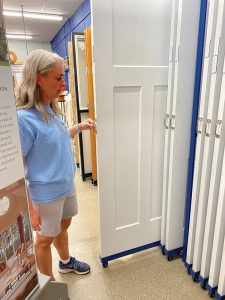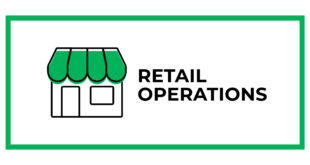With the recent uncertainty in lumber pricing due to the pandemic and continuing supply chain issues, optimizing your LBM category is essential to its success.
M&M Lumber Co. was established in 1964 in Tulsa, Oklahoma, by Jim McKellar Sr. and Ernest Miller and today includes a 10,000-square-foot store and a 10-acre lumberyard. The company is in its third generation of leadership, with Jim’s granddaughter Whitney McKellar and her husband Sean Stevens sharing ownership responsibilities with McKellar’s father, Jim McKellar Jr. Whitney grew up in the business and Sean spent his summers in high school and college working at the company. They have both spent the last 25 years involved in every part of the business and began sharing ownership responsibilities with McKellar’s father in the mid 2000s. Hardware Retailing spoke with McKellar about the practices and merchandising she has utilized to build a better LBM category.
THE MORE YOU KNOW
M&M Lumber Co. usually has around 40 employees on-site at a time and its staff members have over 400 years of combined lumber and building material experience.
“Having that much experience allows us to better serve our customers and sets us apart from our competition,” McKellar says. “It also helps with efficiency and sales.”
If you want to boost the knowledge of your lumberyard staff, explore the North American Hardware and Paint Association’s (NHPA) Basic Training in Building Materials Retailing program to discover product knowledge in eight core building materials departments. Each course outlines the benefits and features of basic products and key selling skills. Visit YourNHPA.org/academy to learn more.
Rules to Live By
Product mix can make a big difference in your efficiency and success. Providing a broad selection of inventory, while still being mindful that you cannot provide everything to every customer, can also go a long way to becoming more efficient, McKellar says.
“We merchandise ‘good’ and ‘best’ for products while skipping over ‘better,’” McKellar says. “This strategy cuts down on inventory dollars while still giving customers options.”
This practice can also prevent decision paralysis and lead to more purchases. Finding the niche that resonates with your customer base and merchandising those areas thoughtfully helps with sales, McKellar says.
“We have chosen quality over price for much of our LBM inventory,” McKellar says. “We have partnered with vendors that have higher-grade materials, which leaves less product to be culled at the end of the day.”
And while a niche might work for a while, it might not work forever. It’s crucial to continually evaluate what is and isn’t working for your operation.
“It is important to pivot when needed and not be afraid to do so,” McKellar says. “Enacting change, especially when it makes your operation more efficient, leads to a better bottom line.”
Seeking Safety
5 QUESTIONS TO ASK TO IMPROVE SAFETY IN YOUR LUMBERYARD
Lumberyards are full of activity—employees on forklifts moving materials, workers inspecting supplies and customers loading products into their vehicles. It’s crucial that every lumberyard operates within an established process and each employee fully understands that process to ensure the safety of everyone who comes into the space.
Every lumberyard should have a process in place that addresses the specific activities that happen daily. Talk through the following questions to help your team understand your processes for keeping employees and customers safe in the lumberyard.
1. Do you allow customers to load their own materials? If so, what are some steps you can take to be sure each customer can do so safely? If not, how can you explain to customers why they are asked not to load materials?
2. What equipment do you have in the lumberyard? What credentials are required to operate it? What are the safety measures you should take with each piece of equipment before using it?
3. What signage is posted in the lumberyard? When should signage be replaced or updated?
4. What should you do if you witness something unsafe in the lumberyard, whether it’s an employee or a customer acting unsafely or poorly stored materials?
5. What are some specific rules your operation has in place to keep employees and customers safe in the lumberyard?
Learn more by watching this video on lumberyard safety at hardwareretailing.com/lumberyard-safety.
Making Peace
6 TIPS FOR DEALING WITH TROUBLESOME CUSTOMERS
While many customers may be unaware of the supply chain issues or think the worst is in the past, there are still products that are tough to stock.
“Customers expect full stock in inventory,” Whitney McKellar says. “Many don’t understand why we still don’t have all items in stock and why product is still on allocation.”
While no one likes dealing with upset customers, it’s inevitable that sooner or later you’ll have to. When that time comes, it’s important to know how to deal with them properly. Remind employees that upset customers represent an opportunity to turn a bad experience into a good one and gain a loyal customer.
1. Ask the customer why they are upset and listen carefully to the reason. If you need to, take notes and repeat back the complaint to the customer to make sure you have all the details correct. Then, thank them for bringing the matter to your attention.
2. When talking to the customer, use phrases like “I see” and “I understand.” These phrases show the customer you are listening to them, while not implying the customer is right or wrong.
3. If the customer has already talked to an employee about their complaint during a previous store visit, try to connect the customer with that employee to minimize confusion.
4. If the product is a return, examine the product together. Sometimes, the problem is less serious than the customer thinks or a misunderstanding. Some customers will realize they caused an issue, which can change their expectations of you trying to solve the problem.
5. If the customer is very upset, you want to avoid embarrassment and disturbing other customers. You also don’t want the upset customer to negatively affect the attitude of other customers. Ask them to step aside to a place off the main salesfloor where you can talk.
6. After you understand the complaint, ask “What can we do to make this right?” Offer a solution that’s in line with store policy. Sometimes you can solve the problem and offer compensation in the form of customer service instead of just a free product.

Special Services
M&M Lumber offers services such as special orders, delivery and more to its customers, and its lumberyard is split by a railroad, which allows for easy product deliveries. It also stores window screens for builders.
“If window screens are put in before a new build is complete, nine times out of ten those screens get damaged by the end of the job,” McKellar says. “We developed an alphabetical code that we use to label the screens, and we store them until builders are ready for their final walkthrough.”
M&M Lumber also runs a custom door shop, a niche they have found works with their customer base, but comes with its own set of challenges.
“When running a door shop, it is important to be flexible; nothing is standard anymore,” McKellar says. “It is key to take the time to understand what the customer wants, but set expectations of what is doable and if it is something that is attainable for them.”
 Reducing Waste
Reducing Waste
With recent high lumber prices and inflation, finding innovative ways to reuse and repurpose materials can positively impact a business. M&M Lumber reduces waste by repurposing scraps and damaged products into sellable products, like shims, when possible.
 Hardware Retailing The Industry's Source for Insights and Information
Hardware Retailing The Industry's Source for Insights and Information








